Project: ABVD: Austronesian Basic Vocabulary Database
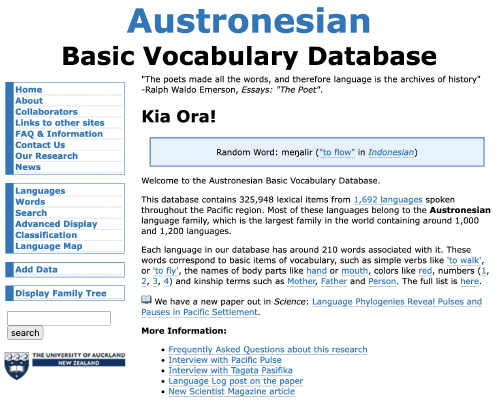
The Austronesian Basic Vocabulary Database is the world’s largest cross-linguistic database of the Pacific. It contains ~300,000 lexical items from ~1,600 languages spoken throughout the Pacific region.
Publications from this Project:
Bayesian phylogenetic analysis of Philippine languages supports a rapid migration of Malayo Polynesian languages.

King B, Greenhill SJ, Reid LA, Ross M, Walworth M, & Gray R. 2024. Bayesian phylogenetic analysis of Philippine languages supports a rapid migration of Malayo Polynesian languages. Scientific Reports, 14, 14967.
The Philippines are central to understanding the expansion of the Austronesian language family from its homeland in Taiwan. It remains unknown to what extent the distribution of Malayo-Polynesian languages has been shaped by back migrations and language leveling events following the initial Out-of-Taiwan expansion. Other aspects of language history, including the effect of language switching from non-Austronesian languages, also remain poorly understood. Here we apply Bayesian phylogenetic methods to a core-vocabulary dataset of Philippine languages. Our analysis strongly supports a sister …
Abstract PDF 10.1038/s41598-024-65810-xPopulation Size and the Rate of Language Evolution: A Test Across Indo-European, Austronesian, and Bantu Languages.
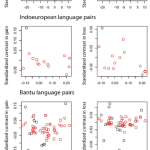
Greenhill SJ, Hua X, Welsh CF, Schneemann H & Bromham L. 2018. Population Size and the Rate of Language Evolution: A Test Across Indo-European, Austronesian, and Bantu Languages. Frontiers in Psychology, 9:576.
What role does speaker population size play in shaping rates of language evolution? There has been little consensus on the expected relationship between rates and patterns of language change and speaker population size, with some predicting faster rates of change in smaller populations, and others expecting greater change in larger populations. The growth of comparative databases has allowed population size effects to be investigated across a wide range of language groups, with mixed results. One recent study of a group of Polynesian languages revealed greater rates of word gain in larger …
Abstract PDF 10.3389/fpsyg.2018.00576Rise and fall of political complexity in island South-East Asia and the Pacific.
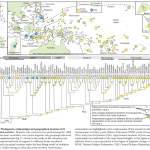
Currie TE, Greenhill SJ, Gray RD, Hasegawa T & Mace R. 2010. Rise and fall of political complexity in island South-East Asia and the Pacific. Nature, 467:801-804.
There is disagreement about whether human political evolution has proceeded through a sequence of incremental increases in complexity, or whether larger, non-sequential increases have occurred. The extent to which societies have decreased in complexity is also unclear. These debates have continued largely in the absence of rigorous, quantitative tests. We evaluated six competing models of political evolution in Austronesian-speaking societies using phylogenetic methods. Here we show that in the best-fitting model political complexity rises and falls in a sequence of small steps. This is …
Abstract Get Paper 10.1038/nature09461How Accurate and Robust Are the Phylogenetic Estimates of Austronesian Language Relationships?.
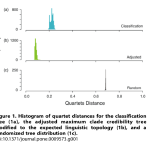
Greenhill SJ, Drummond AJ & Gray RD. 2010. How Accurate and Robust Are the Phylogenetic Estimates of Austronesian Language Relationships? PLoS ONE, 5(3): e9573.
We recently used computational phylogenetic methods on lexical data to test between two scenarios for the peopling of the Pacific. Our analyses of lexical data supported a pulse-pause scenario of Pacific settlement in which the Austronesian speakers originated in Taiwan around 5,200 years ago and rapidly spread through the Pacific in a series of expansion pulses and settlement pauses. We claimed that there was high congruence between traditional language subgroups and those observed in the language phylogenies, and that the estimated age of the Austronesian expansion at 5,200 years ago was …
Abstract PDF 10.1371/journal.pone.0009573Darwin, language, and two great Pacific voyages.
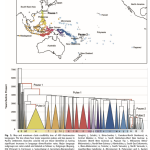
Greenhill SJ, & Gray RD. 2009. Darwin, language, and two great Pacific voyages. New Zealand Science Review, 66: 97-101.
On the 21st of December 1835 Charles Darwin arrived in New Zealand on the HMS Beagle. The Beagle had just visited the Galapagos islands, where Darwin had made some of the critical observations that he would later incorporate into his theory of evolution. Darwin did not like New Zealand: "I believe we were all glad to leave New Zealand. It is not a pleasant place. Amongst the natives there is absent that charming simplicity which is found in Tahiti; and the greater part of the English are the very refuse of society. Neither is the country itself attractive. (Darwin 1860, p. 430)". Around 1000 …
Abstract PDFAustronesian language phylogenies: Myths and misconceptions about Bayesian computational methods.
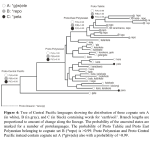
Greenhill SJ & Gray RD. 2009. Austronesian language phylogenies: Myths and misconceptions about Bayesian computational methods. In Austronesian historical linguistics and culture history: a festschrift for Robert Blust (Pp 375-397). A. Adelaar & A. Pawley (Eds). Canberra: Pacific Linguistics.
Historical linguistics has never been particularly intimate with computers. The first wave of computational historical linguistics—lexicostatistics—was developed in the 1950s and quickly applied to language groups around the world from Indo-European to Austronesian. However, critics were quick to point out the problems caused by assuming a single constant rate of lexical replacement and repeatedly noted the erroneous results that this produced. As a consequence of these critiques lexicostatistics has been widely rejected by mainstream historical linguists. The last few years have seen a second …
Abstract PDFMatrilocal residence is ancestral in Austronesian societies.
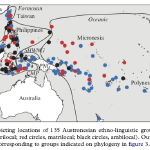
Jordan FM, Gray RD, Greenhill SJ & Mace R. 2009. Matrilocal residence is ancestral in Austronesian societies. Proceedings of the Royal Society B. 276:1957-1964.
The nature of social life in human prehistory is elusive, yet knowing how kinship systems evolve is critical for understanding population history and cultural diversity. Post-marital residence rules specify sex-specific dispersal and kin association, influencing the pattern of genetic markers across populations. Cultural phylogenetics allows us to practise "virtual archaeology" on these aspects of social life that leave no trace in the archaeological record. Here we show that early Austronesian societies practised matrilocal post-marital residence. Using a Markov-chain Monte Carlo comparative …
Abstract PDF 10.1098/rspb.2009.0088Language Phylogenies Reveal Expansion Pulses and Pauses in Pacific Settlement.

Gray RD, Drummond AJ, & Greenhill SJ. 2009. Language Phylogenies Reveal Expansion Pulses and Pauses in Pacific Settlement. Science, 323: 479-483.
Debates about human prehistory often center on the role that population expansions play in shaping biological and cultural diversity. Hypotheses on the origin of the Austronesian settlers of the Pacific are divided between a recent “pulse-pause” expansion from Taiwan and an older “slow-boat” diffusion from Wallacea. We used lexical data and Bayesian phylogenetic methods to construct a phylogeny of 400 languages. In agreement with the pulse-pause scenario, the language trees place the Austronesian origin in Taiwan approximately 5230 years ago and reveal a series of …
Abstract Get Paper 10.1126/science.1166858 WebsiteThe Austronesian Basic Vocabulary Database: From Bioinformatics to Lexomics.
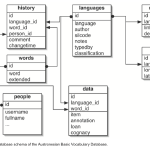
Greenhill SJ, Blust R, & Gray RD. 2008. The Austronesian Basic Vocabulary Database: From Bioinformatics to Lexomics. Evolutionary Bioinformatics, 4:271-283.
Phylogenetic methods have revolutionised evolutionary biology and have recently been applied to studies of linguistic and cultural evolution. However, the basic comparative data on the languages of the world required for these analyses is often widely dispersed in hard to obtain sources. Here we outline how our Austronesian Basic Vocabulary Database (ABVD) helps remedy this situation by collating wordlists from over 500 languages into one web-accessible database. We describe the technology underlying the ABVD and discuss the benefits that an evolutionary bioinformatic approach can provide. …
Abstract PDF 10.4137/EBO.S893 Website